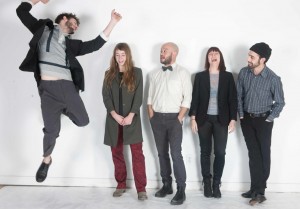
Dancemakers creates an organically inspired piece with their latest dance work in Toronto
I tend to avoid reading program notes before seeing shows, but when I opened the program for Dancemakers’ newest work, loveloss by Michael Trent, the first thing I saw was a section entitled “notes on notes.” Out of intrigue I began to read the section before the show began. The thing that resonated was Dancemakers’ statement that they work hard to not give anything away in their program notes. So this has left me feeling very torn about how to write this review because, I too, don’t want to give anything away.
Dancemakers shows are always such a treat to attend because I know that I will be seeing something innovative unfold. For loveless one of the most significant innovations is the use of the space. The theatre has been stripped of its wings and instead the audience’s seats surround the perimeter of the performance space. Throughout the evening I caught myself frequently staring at the people sitting across from me and comparing their reaction to the show to my own. It isn’t often that as an observer, or even as a performer, you can so clearly see people’s physical reactions to what you are participating in. Often I would follow someone else’s gaze to see what exactly it was that was drawing their attention in that moment.
As always, the Dancemakers ensemble is breathtaking to watch. I was left in awe of how in sync they are as a group, yet how unique each individual member is. This was made even more apparent than usual due to the significant amount of improvisation which Trent has included in loveless. It really allowed the dancers to shine.
Personally my guest and I found that loveloss started off a little slow. It wasn’t until the final dancer, Robert Abubo, entered the space that the piece began to really pick up. My overall impression of the work was that it was full of subtlety. A glance or small facial expression could carry a lot.
loveloss was also overflowing with powerful visual images. The set seems quite simple upon first glance, but as someone that has spent a significant amount of time working in theatres I could see the amount of detail that went into making it appear so pristine. It is also very fluid and pliable. This mobility caused the space to act as a sixth character in Trent’s work. Its ability to literally organically shift throughout the work gave loveloss an organic feel. It is literally impossible for the piece to ever even appear the same due to the fluid nature of the performance space. I found the dancers interactions with the space very captivating.
As slow as I found loveloss to build in momentum, I then found that the ending came very suddenly. I wasn’t quite prepared for the work to be over, especially in as dramatic a way as it did. Considering how organic the rest of the work had felt, I found the ending to strongly contrast this sentiment. I had been placed in an almost hypnotic state by the combination of the dancers movement and the music by Christopher Willes. When the end came I felt jolted out of my daze. Not that that is necessarily a bad thing.
Upon returning home and finishing reading through the rest of the program notes, I could clearly find connections between what I had seen and felt, and the themes that Trent had been working with. loveloss tackles the challenging subject of having someone you love pass away in a subdued and understated manner. It allows space for the viewer to come to their own conclusions and contemplate their personal experiences of loss and love. I am always supportive of work which openly invites the observer to draw their own conclusions.
- loveloss is playing at Dancemakers Centre for Creation (9 Trinity St, in the Distillery District) untill February 24, 2013
- performances are February 21-23 at 8pm and February 17 and 24 at 4pm
- Tickets are between $20 and $25
- Tickets can be purchased online or by calling 416-367-1800
